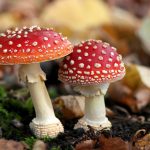 A eukaryotic (nucleated) group of microbes. A phylum of plants whose members are devoid of any pigment capable of photosynthesis; they are unable to synthesize protein or other organic material from simple compounds, and are therefore parasitic or saprophytic.
A eukaryotic (nucleated) group of microbes. A phylum of plants whose members are devoid of any pigment capable of photosynthesis; they are unable to synthesize protein or other organic material from simple compounds, and are therefore parasitic or saprophytic.
Plants which contain no chlorophyll, that is, molds.
A very large group of organisms, now considered to belong to a kingdom separate from both plants and animals, with vegetative bodies consisting of fine, almost invisible threads, or single cells, or even aggregations of naked protoplasm (the slime molds). Many fungi produce more conspicuous spore-bearing organs, as in the mushrooms, toadstools and puffballs. Fungi, unlike green plants, cannot synthesize their food from soil minerals but must utilize organic foods that have been synthesized by other organisms: they may feed either on dead matter (saprophytes) or living plants or animals (parasites). Many plant diseases are caused by parasitic fungi, but saprophytic fungi play a vital role in breaking down dead plant material, channeling it back into the nutrient cycle.
A diverse group of organisms that obtain food by absorbing nutrients directly. With bacteria, they are responsible for the decay and decomposition of organic matter. Fungi may also cause mold-related illnesses in people who spend substantial amounts of time in water-damaged buildings. Some fungi are parasites on living organisms, including humans, and can cause serious infections and diseases. Fungi also have beneficial medical uses. An alkaloid in one fungus may be used to stimulate uterine contractions in childbirth. Antibiotics such as penicillin, which are now produced by nonfungal microorganisms, were originally derived from a fungus. The antifungal antibiotic griseofulvin is made from fungi, and the immunosuppressant medications cyclosporine and tacrolimus, which are used in organ transplantation, are both derived from fungi.
Microscopic plant parasites, which include molds, mildews, and yeasts; can produce contagious diseases such as ringworm.
Fungi are simple parasitic life-forms that encompass various organisms such as yeasts, moulds, mushrooms, and toadstools. Among the fungi responsible for causing diseases, two main groups can be distinguished: filamentous fungi and yeasts. Filamentous fungi consist of branching threads called hyphae, which form a network known as a mycelium. The visible mushrooms and toadstools are the reproductive structures, also called fruiting bodies, produced by filamentous fungi as they spread in dead matter or soil. On the other hand, yeasts are single-celled organisms.
Most fungi are either entirely harmless or even beneficial to human health. Nonetheless, there are certain fungi that have the potential to cause illness and disease.
The reproductive structures, or fruiting bodies, of certain fungi can harbor toxins that may lead to poisoning if consumed (known as mushroom poisoning). Additionally, some fungi infect food crops and produce toxins that can cause food poisoning. One well-known example is a species that infects cereals and generates ergot, a toxin that narrows blood vessels. Another fungus occasionally found on peanuts produces aflatoxin, a poisonous and carcinogenic substance.
Certain fungi release spores that, when inhaled, can trigger allergic alveolitis, a chronic allergic reaction affecting the lungs. An instance of this is Farmer’s lung, which arises from exposure to spores from moldy hay. Fungal spores can also be responsible for other allergic conditions, including allergic rhinitis (hay fever) and asthma.
Certain fungi have the ability to infiltrate the body and establish colonies in different areas, such as the lungs, skin, or various tissues throughout the body. This can give rise to a spectrum of conditions, ranging from mild irritation to severe and potentially fatal widespread infections and illnesses.
